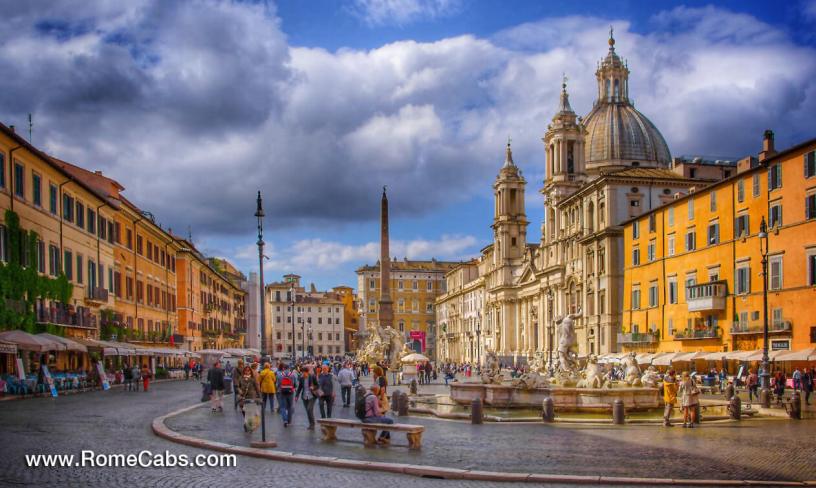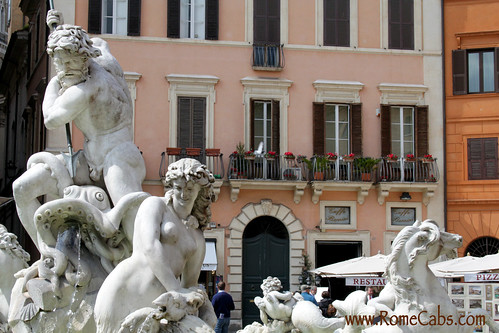Buongiorno and welcome to RomeCabs Rome Travel Blog! Piazza Navona is one of Rome’s most famous squares, captivating visitors with its Baroque fountains, lively atmosphere, and historical landmarks. But how did this iconic piazza get its name? To fully appreciate Piazza Navona’s legacy, we need to travel back to ancient Rome and uncover its origins, explore its remarkable attractions, and dive into the vibrant surroundings that make it a must-visit destination.
Origins of Piazza Navona’s name: Travel Back in time to Ancient Rome
Piazza Navona owes much of its history to Emperor Domitian’s vision of bringing Greek-style athletic competitions into Roman society. Domitian, known for his ambition and desire to be celebrated as a godlike figure, commissioned the stadium (Stadium of Domitian) around 86 AD to host agones—athletic events inspired by the games of ancient Greece.
Unlike Rome’s gladiatorial arenas, the stadium was constructed specifically for foot races, boxing, discus throwing, and other competitive sports. This cultural shift toward Greek-influenced events was part of Domitian’s larger aim to bolster his prestige while encouraging a renewed emphasis on athleticism and the arts in Roman life.
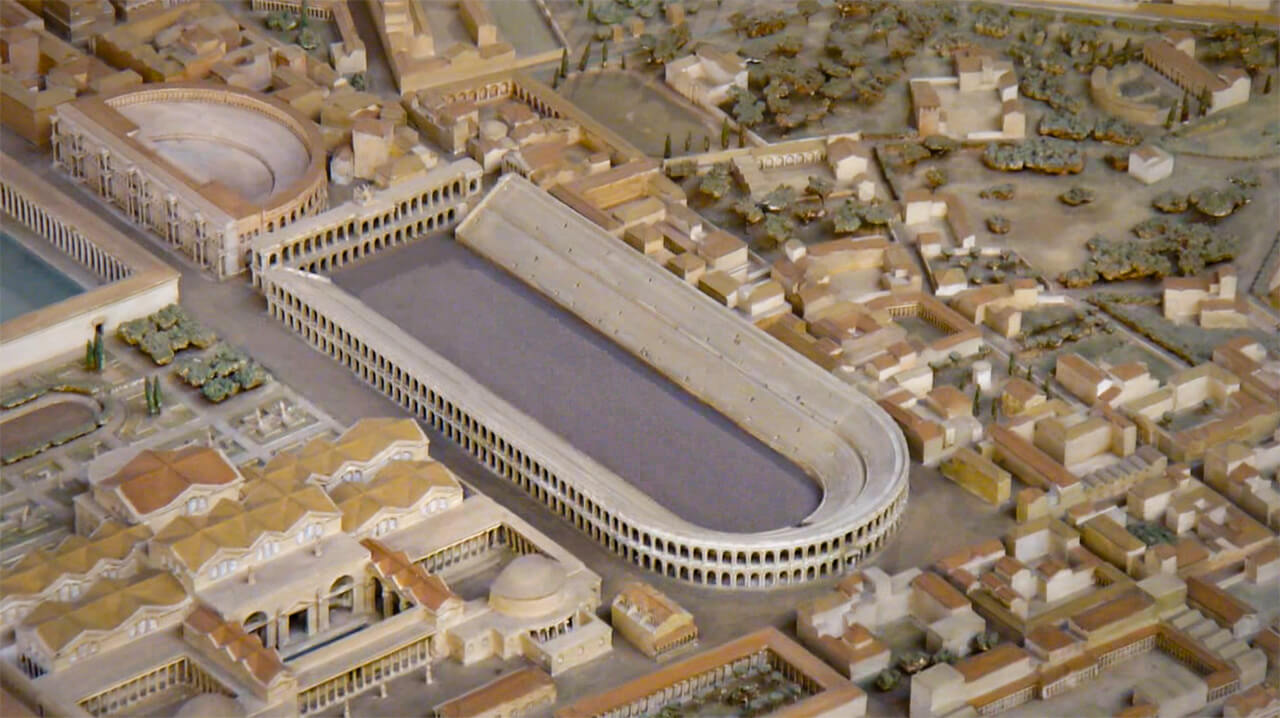
The stadium itself was a marvel of engineering and design, constructed in an elongated, horseshoe shape with tiered seating, which still influences Piazza Navona’s structure today. Its layout was different from other prominent venues like the Colosseum, demonstrating a unique architectural form that emphasized its Greek-inspired purpose.
The outer dimensions of the Stadium of Domitian stretched approximately 275 meters in length and 106 meters in width, with stone seating for an impressive 30,000 spectators. Built with travertine and brick, the structure was richly decorated with sculptures and painted marble, creating a striking venue worthy of Rome’s elite and the emperor’s prestigious events.
After Domitian’s assassination in 96 AD, the stadium remained an important fixture in Rome, continuing to host athletic games and even naval battles. The name “Navona” is widely believed to derive from the phrase “in agone” (meaning “in the games”), a reference to the competitive spirit of the events once held there. Over time, “in agone” morphed into “Navone” and eventually “Navona“, a subtle nod to the site’s athletic origins embedded in the language and identity of Rome.
From Ancient Stadium to Today’s Vibrant Piazza
After the fall of the Roman Empire, the Stadium of Domitian slowly deteriorated, with much of its stone repurposed for newer buildings across Rome. By the Middle Ages, the former stadium’s outline had mostly vanished, leaving only hints of its grandeur.
However, its unique, elongated shape continued to define the area, which became known as Campus Agonis. During this time, the square hosted open-air markets, religious processions, and public gatherings, establishing its role as a central space for the community.
The 17th century marked a decisive turning point for Piazza Navona, thanks to the ambitions of Pope Innocent X (Giovanni Battista Pamphilj). The Pamphilj family, one of Rome’s influential noble families, owned properties around the piazza, and Innocent X aimed to elevate both his family’s status and the city’s appeal. This vision sparked an ambitious redevelopment of Piazza Navona, positioning it as a grand public space showcasing the artistic achievements of the Baroque era.
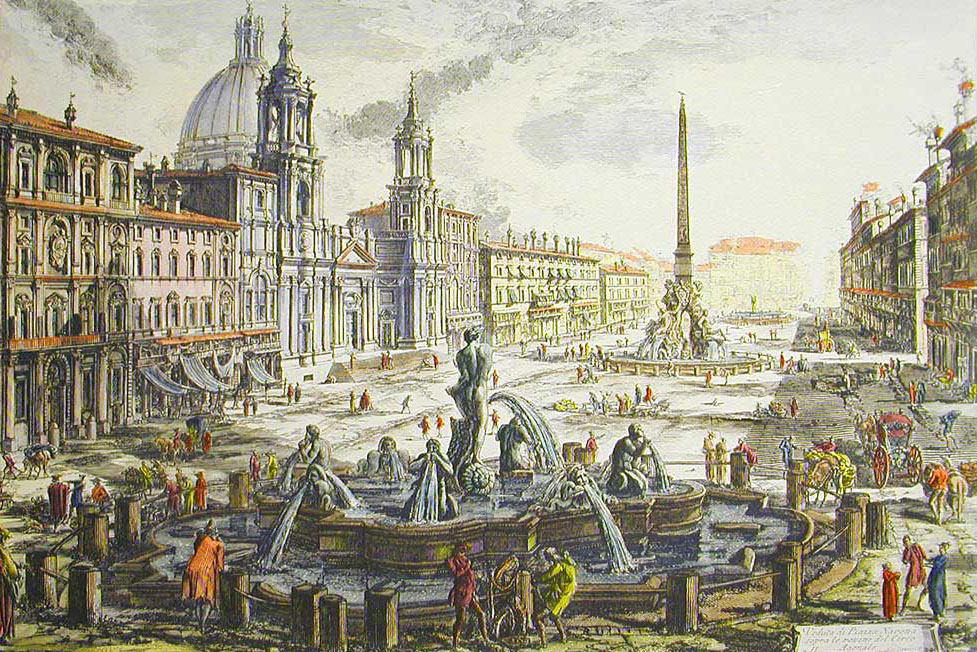
The Role of Bernini and Borromini: Rivals in Art
To bring his vision to life, Innocent X called upon two of Rome’s most brilliant, yet rival, artists: Gian Lorenzo Bernini and Francesco Borromini. Each left a distinct mark on the piazza, and their artistic rivalry added layers of creativity and drama to its development.
Bernini and the Fontana dei Quattro Fiumi
One of Innocent X’s most famous commissions for the square was the Fontana dei Quattro Fiumi (Fountain of the Four Rivers), created by Bernini in 1651. This fountain became an iconic centerpiece of the square, blending water, sculpture, and symbolism in a striking display. Featuring allegorical figures of four great rivers—the Nile, Ganges, Danube, and Rio de la Plata—the fountain represents the four known continents of the world. At the top stands an Egyptian-style obelisk, symbolizing the church’s triumph over paganism.
Interestingly, Bernini was not initially chosen for the project due to his tense relationship with Pope Innocent X. However, with the help of a powerful friend, Donna Olimpia Pamphilj, Bernini managed to present a model of the fountain to the pope, who was reportedly so impressed that he immediately selected Bernini for the commission. The fountain’s grandeur and symbolic depth made it one of the Baroque period’s most celebrated works, cementing Bernini’s place as one of the era’s master sculptors.
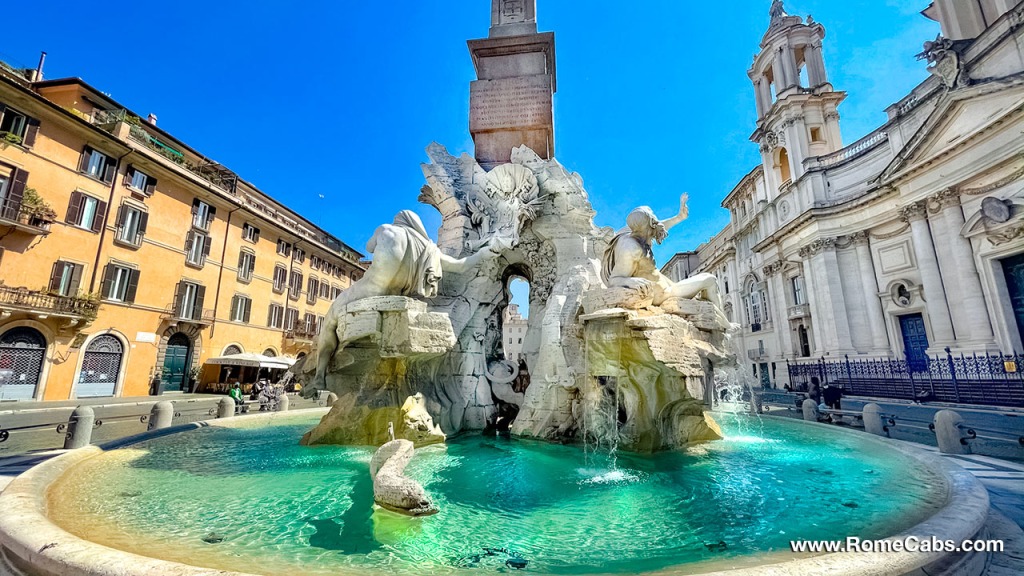
Borromini and Sant’Agnese in Agone
While Bernini created the grand fountain, Francesco Borromini was commissioned to redesign the church of Sant’Agnese in Agone, located on the piazza’s western side. Dedicated to Saint Agnes, a young martyr who, according to legend, was executed on the site, the church carries significant historical and religious importance. Borromini’s architectural style was bold and innovative, marked by concave and convex surfaces, which gave the church’s façade a sense of movement and fluidity.
Borromini’s work on Sant’Agnese in Agone transformed the church into a Baroque masterpiece that visually anchors the piazza. His design complemented Bernini’s fountain and added to the overall sense of harmony and movement that defines Piazza Navona today. Despite their contrasting styles and personal rivalry, Bernini and Borromini’s works created a cohesive visual experience, blending architecture and sculpture into a dynamic expression of Baroque ideals.
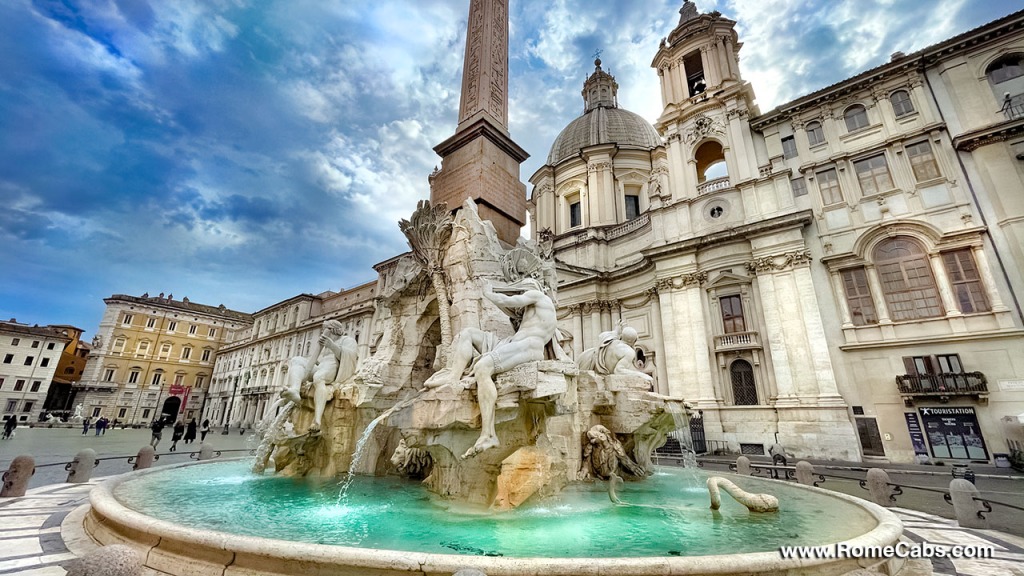
Piazza Navona: A Baroque Cultural Hub
With its Baroque redesign complete, Piazza Navona quickly became a social and cultural focal point for Rome. The elaborate fountains, including the Fontana del Moro and the Fontana del Nettuno at the square’s ends, and the richly adorned façades of buildings created an open-air gallery that drew locals and visitors alike. Lavish festivals and public events were frequently held in the piazza, adding to its lively atmosphere.
During the summer, one of the most notable traditions was the “Lago di Piazza Navona” (Lake of Piazza Navona). In this annual event, the fountains were used to flood the piazza, transforming it into a shallow lake where nobles would parade in carriages, and Romans would gather to cool off and enjoy the spectacle. This tradition, which continued until the late 19th century, further emphasized the piazza’s role as a space for community celebration and leisure.
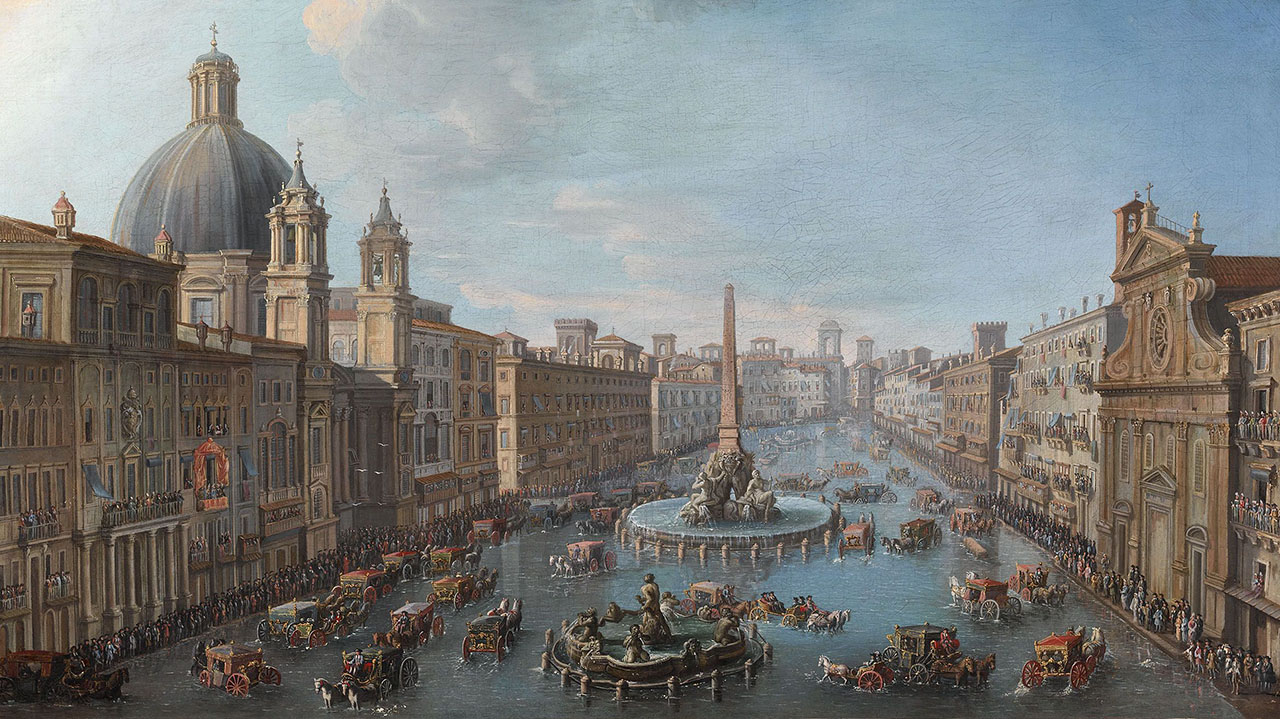
Pope Innocent X’s ambitious transformation was ultimately successful, turning Piazza Navona into a stage for Baroque art and architecture and a vibrant gathering place that continues to enchant visitors today. Its journey from an ancient stadium to a Baroque cultural landmark reflects the enduring legacy of Rome’s ability to adapt, innovate, and celebrate its rich heritage.
What to see in Piazza Navona
Piazza Navona is a feast for the eyes, and there’s no shortage of attractions to discover. From intricate fountains to historical churches, here are the highlights that bring Piazza Navona’s charm to life.
Fontana dei Quattro Fiumi (Fountain of the Four Rivers)
The centerpiece of Piazza Navona is the Fontana dei Quattro Fiumi, or Fountain of the Four Rivers, designed by Gian Lorenzo Bernini in 1651. With its flowing water and lifelike sculptures, Bernini’s fountain remains one of the most celebrated works of Baroque art in Rome.
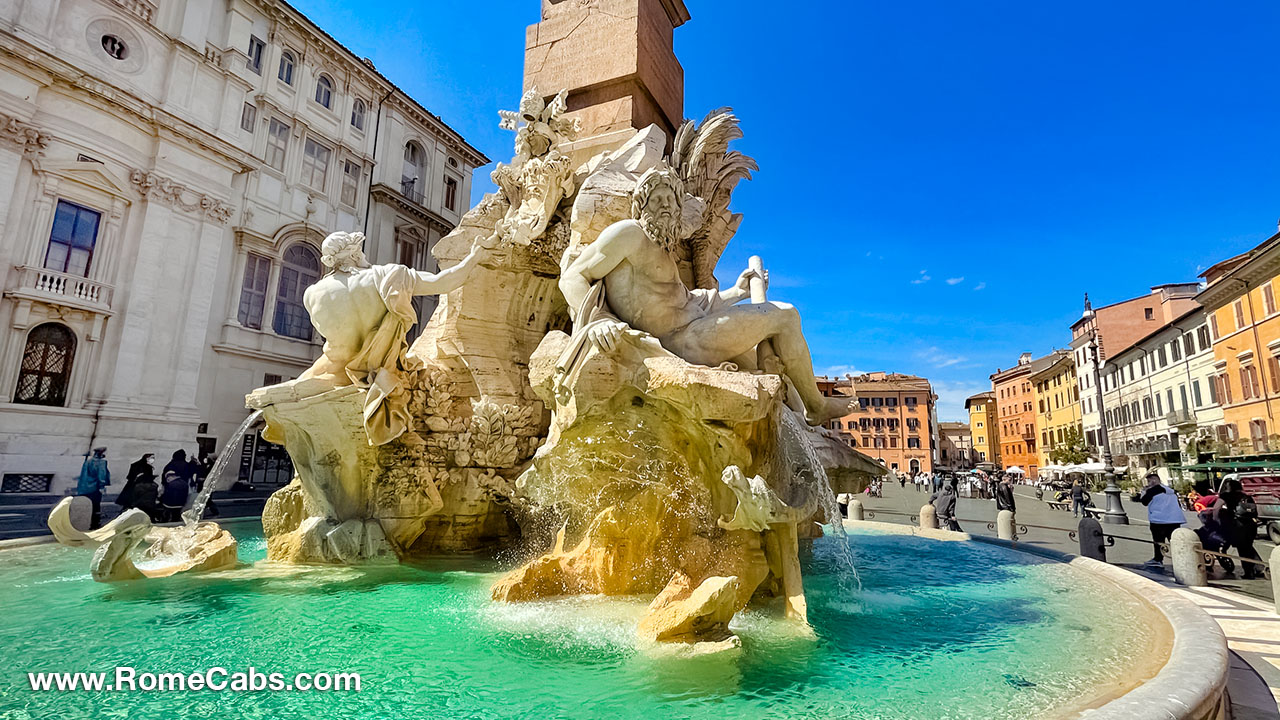
Fontana del Moro and Fontana del Nettuno
At either end of Piazza Navona, you’ll find two more exquisite fountains: the Fontana del Moro (Fountain of the Moor) and the Fontana del Nettuno (Fountain of Neptune). The Fontana del Moro, originally sculpted by Giacomo della Porta and later modified by Bernini, features a central figure of a Moor wrestling a dolphin, surrounded by four Tritons. On the northern end, the Fontana del Nettuno, also designed by della Porta, displays Neptune battling a sea creature, symbolizing the power and beauty of the sea.
These fountains are not only beautiful works of art but also provide balance to the piazza, creating a harmonious and visually stunning space that is quintessentially Roman.
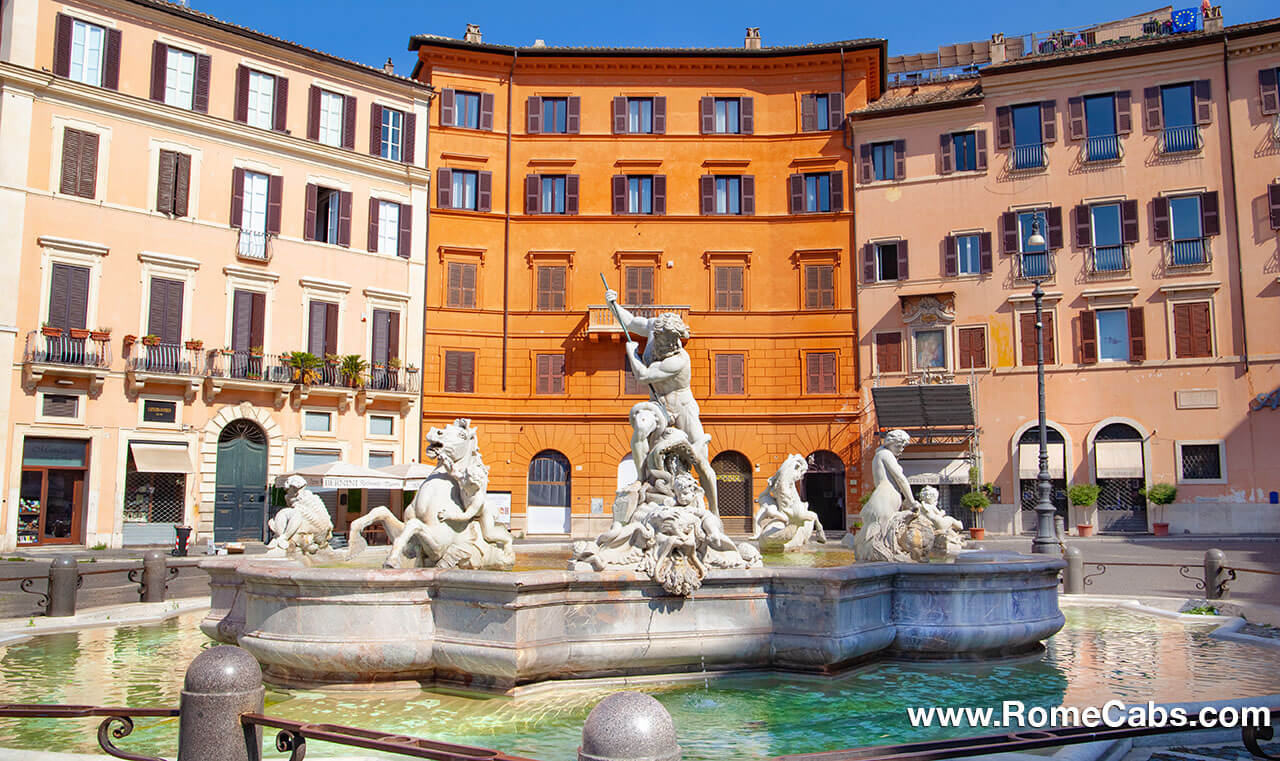
Sant’Agnese in Agone
Overlooking Piazza Navona is the striking church of Sant’Agnese in Agone, designed by Francesco Borromini, Bernini’s contemporary and rival. Built to honor Saint Agnes. According to tradition, Saint Agnes was martyred on this site during the reign of Emperor Diocletian. The church’s name, “in agone“, also harks back to the original name of the stadium, connecting it to the very origins of Piazza Navona.
The church itself is a Baroque marvel, with a façade adorned with sculptures, elegant columns, and intricate details that make it one of the square’s architectural highlights. Step inside to marvel at the frescoes, altars, and the striking dome, which reflects Borromini’s creative vision and unique style.
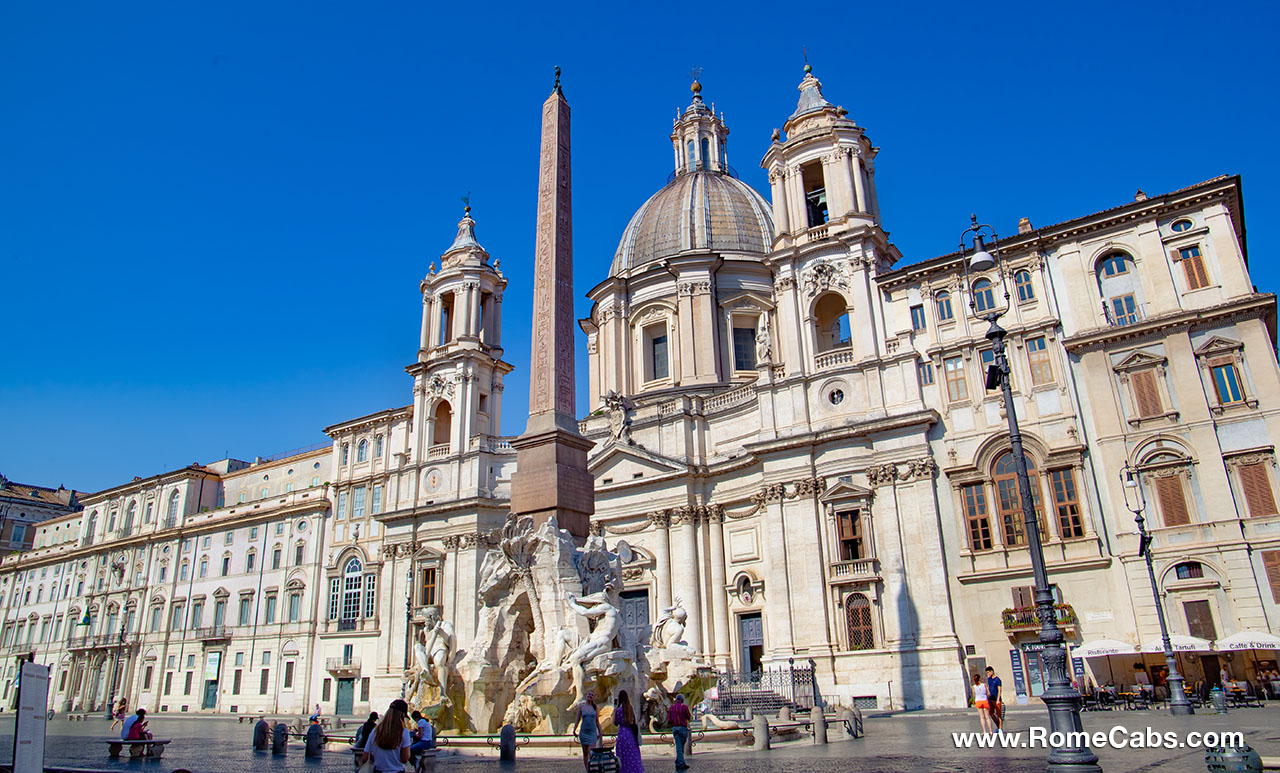
What to See Near Piazza Navona
Once you’ve soaked in the splendor of Piazza Navona, there are several nearby attractions that you won’t want to miss. Here are a few highlights within walking distance, each offering a unique glimpse into Rome’s rich history and culture.
Pasquino: Rome’s Most Famous “Talking Statue”
Just a short walk from Piazza Navona, you’ll find Pasquino, one of Rome’s most famous “talking statue”. Named after an ancient torso believed to represent a hero from Greek mythology, this seemingly unassuming statue became a legendary outlet for Roman satire. From the 16th century onward, Romans anonymously posted witty, critical poems and satirical notes on Pasquino, giving voice to the frustrations and opinions of the public. These messages, often aimed at political figures or social issues, became known as “pasquinades” and were a popular way for citizens to speak out, sometimes boldly, against authority.
Pasquino remains an important symbol of free expression and wit in Rome. Even today, new pasquinades occasionally appear on this historic statue, keeping the tradition of public commentary alive. Visiting Pasquino is a unique experience that offers a glimpse into the spirit of old Rome, where humor and critique merged in the heart of the city.
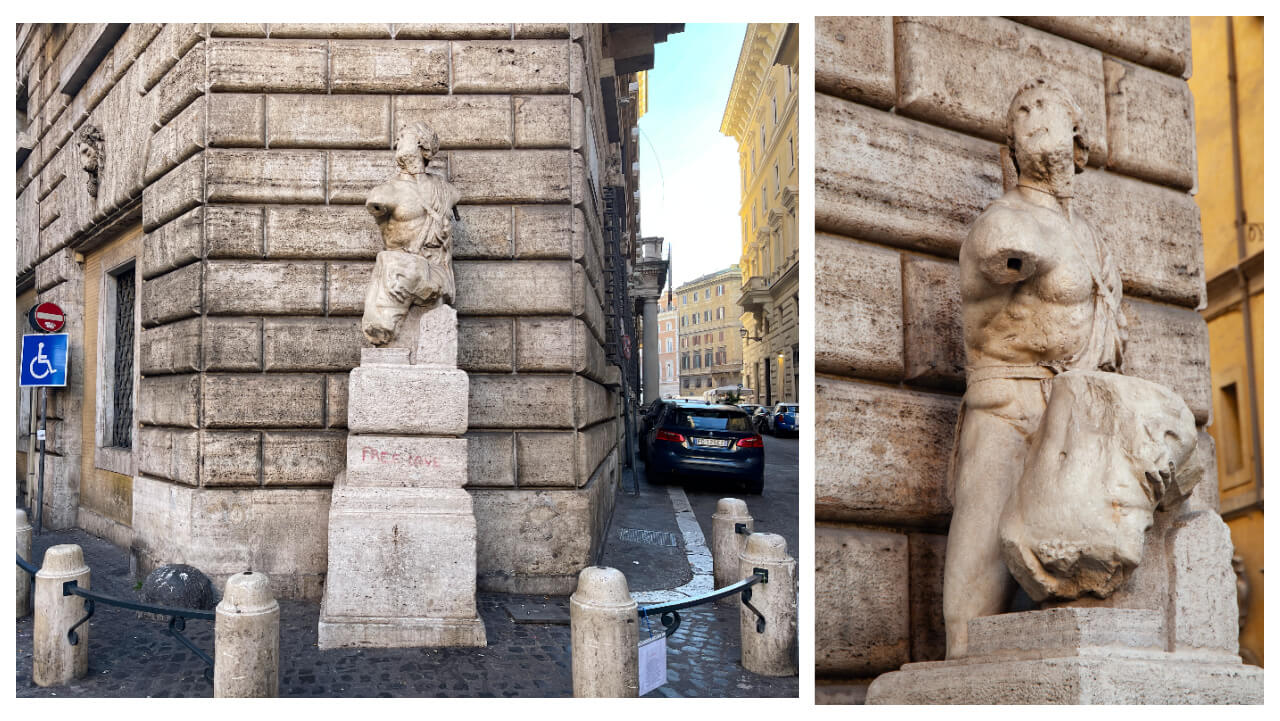
Sant’Agostino Church: A Hidden Gem with a Masterpiece by Caravaggio
Around the corner from Piazza Navona lies Sant’Agostino Church, an architectural and artistic treasure often overlooked by visitors. This 15th-century church, one of the earliest Renaissance-style churches in Rome, houses a stunning collection of artworks, including a remarkable painting by Caravaggio.
Inside, you’ll find Madonna di Loreto (also known as Madonna of the Pilgrims), a Caravaggio masterpiece depicting the Virgin Mary appearing to two humble pilgrims. Caravaggio’s signature realism brings an almost tangible quality to the figures, with the pilgrims shown in worn, dirty feet and ragged clothing, a stark departure from the idealized religious imagery of the time. This painting, located in a side chapel, exemplifies Caravaggio’s revolutionary approach to art, portraying sacred subjects with raw, human emotion.
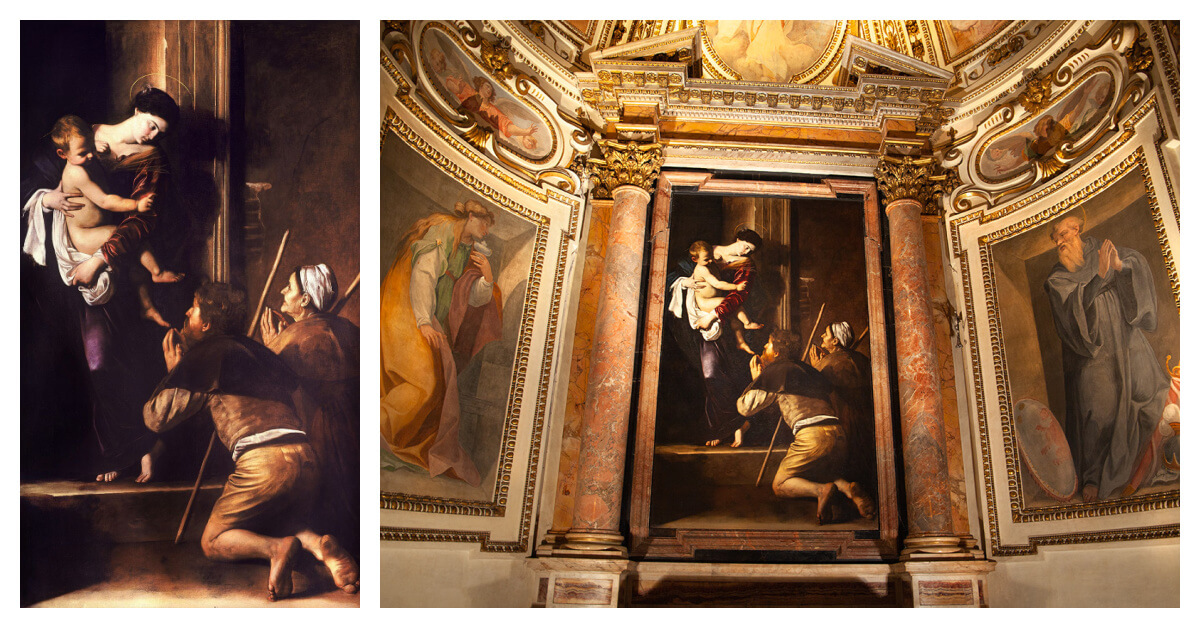
The Pantheon
Just a short stroll from Piazza Navona in Piazza della Rotonda you will reach the Pantheon, one of Rome’s most iconic landmarks. Originally built as a temple dedicated to all the gods, the Pantheon is renowned for its massive dome, central oculus, and remarkably preserved architecture. This architectural marvel is still the world’s largest unreinforced concrete dome.
Stepping inside offers a sense of awe, with light streaming through the oculus, casting a spiritual glow on the interior. Its historical significance and architectural grandeur make the Pantheon a must-visit site. Don’t miss a stroll through Piazza della Rotonda with the fascinating Fountain of the Pantheon topped with an Obelisk.
Almost Behind the Pantheon discover Santa Maria Sopra Minerva, a captivating church that boasts Michelangelo’s “Christ the Redeemer” sculpture.
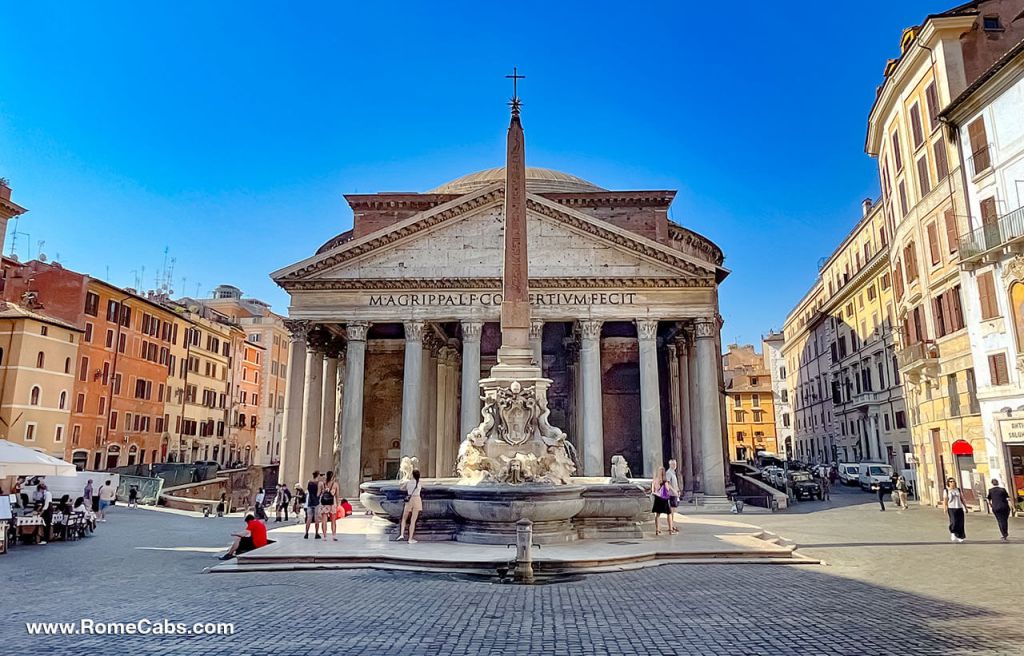
Campo de’ Fiori
For a lively experience, head to Campo de’ Fiori, a bustling square known for its daily market. Here, you’ll find an array of fresh produce, spices, and souvenirs during the day, while the square transforms into a vibrant nightlife hub in the evening.
Dominating the square is the statue of philosopher Giordano Bruno, who was executed here in 1600 due to his controversial ideas. The square’s lively, rustic atmosphere and historical significance make it a fascinating stop near Piazza Navona.
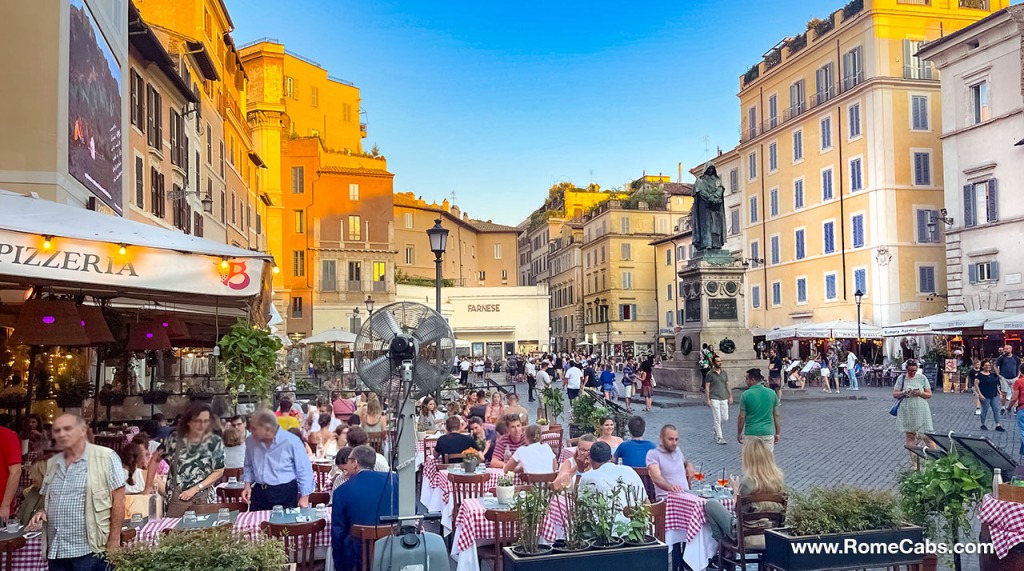
Church of San Luigi dei Francesi
Just minutes from Piazza Navona, the Church of San Luigi dei Francesi (Church of St. Louis of the French) is an essential stop for art enthusiasts. This church is famous for housing three celebrated Caravaggio masterpieces depicting the life of St. Matthew: The Calling of Saint Matthew, The Inspiration of Saint Matthew, and The Martyrdom of Saint Matthew.
These paintings are iconic examples of Caravaggio’s use of chiaroscuro, creating dramatic lighting and intense emotional depth.
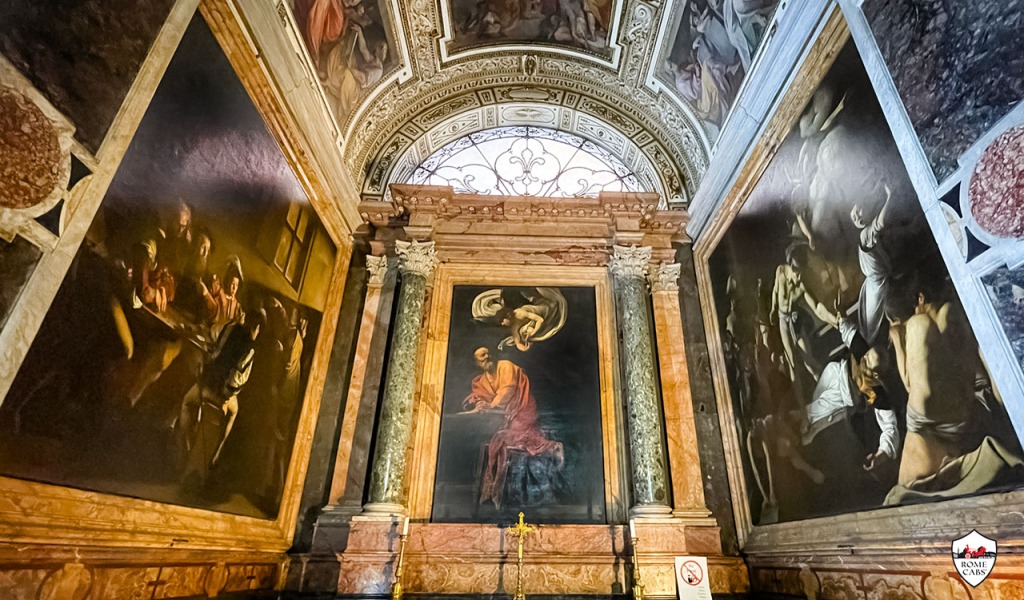
Tips for Visiting Piazza Navona in Rome
To make the most of your visit to Piazza Navona, consider these helpful tips:
- Best Time to Visit Piazza Navona: Early mornings or late evenings are ideal for fewer crowds and a more peaceful experience.
- Photography: The fountains, especially the Fontana dei Quattro Fiumi, are perfect for photography. Sunset is an excellent time to capture the piazza in a golden glow.
- People Watch at Nearby Cafés: Piazza Navona is lined with cafés for the opportunity to sit down, enjoy a beverage, and people-watch. While they are tourist-oriented, you can still find some other authentic spots nearby if you venture a little off the main square.
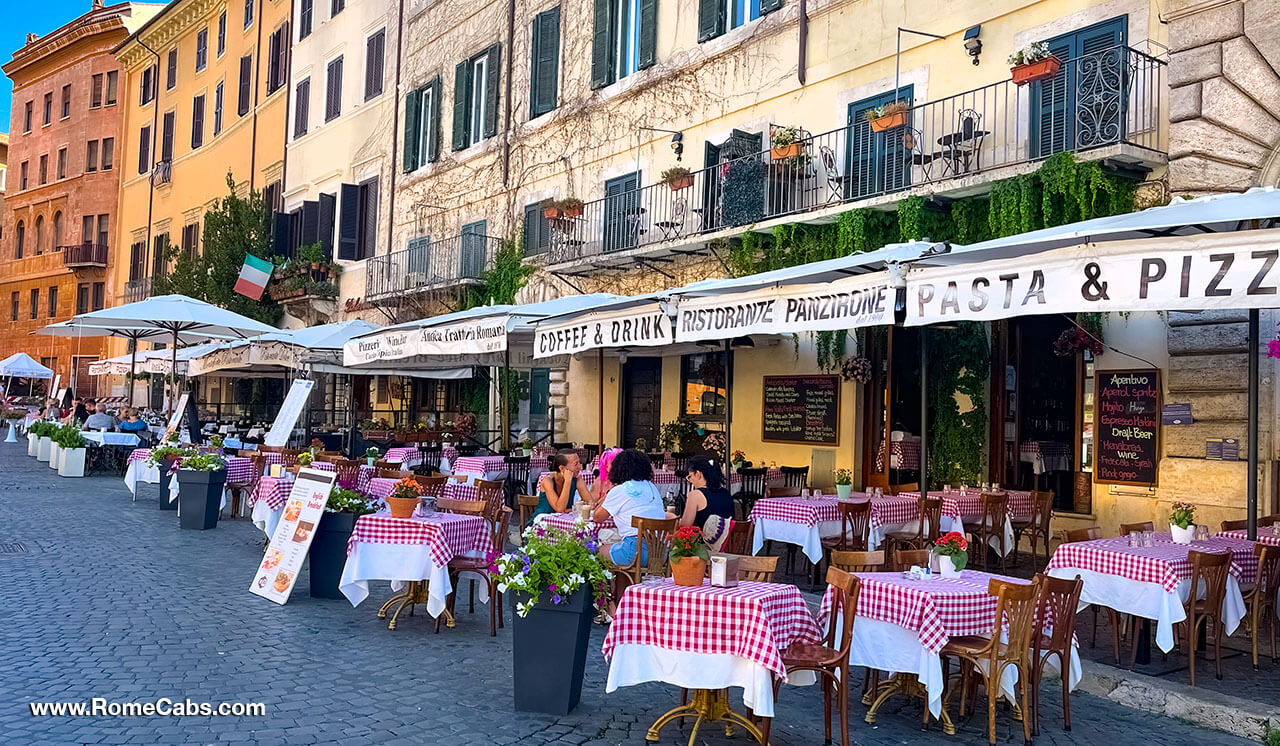
Piazza Navona: A Timeless Roman Experience in Rome
Piazza Navona’s charm lies in its fusion of ancient history, Baroque artistry, and vibrant modern-day life. From its origins as the Stadium of Domitian to its transformation under Pope Innocent X, the piazza reflects centuries of change while maintaining its historical essence. Its captivating fountains, rich history, and central location make it a quintessential Roman experience that no visitor should miss.
Whether you’re drawn by the architectural wonders, the lively ambiance, or the historical tales woven into its name, Piazza Navona promises an unforgettable journey through Rome’s timeless beauty and heritage. So next time you find yourself in Rome, take a stroll through Piazza Navona and let its history and artistry sweep you off your feet.
Find RomeCabs also online:
RomeCabs Facebook: https://www.facebook.com/RomeCabsToursAndTransfers
RomeCabs Pinterest: https://www.pinterest.it/romecabs
RomeCabs Twitter: https://twitter.com/RomeCabs
RomeCabs Instagram: https://www.instagram.com/romecabs/
RomeCabs Flickr Photo Gallery: https://www.flickr.com/photos/romecabs/
